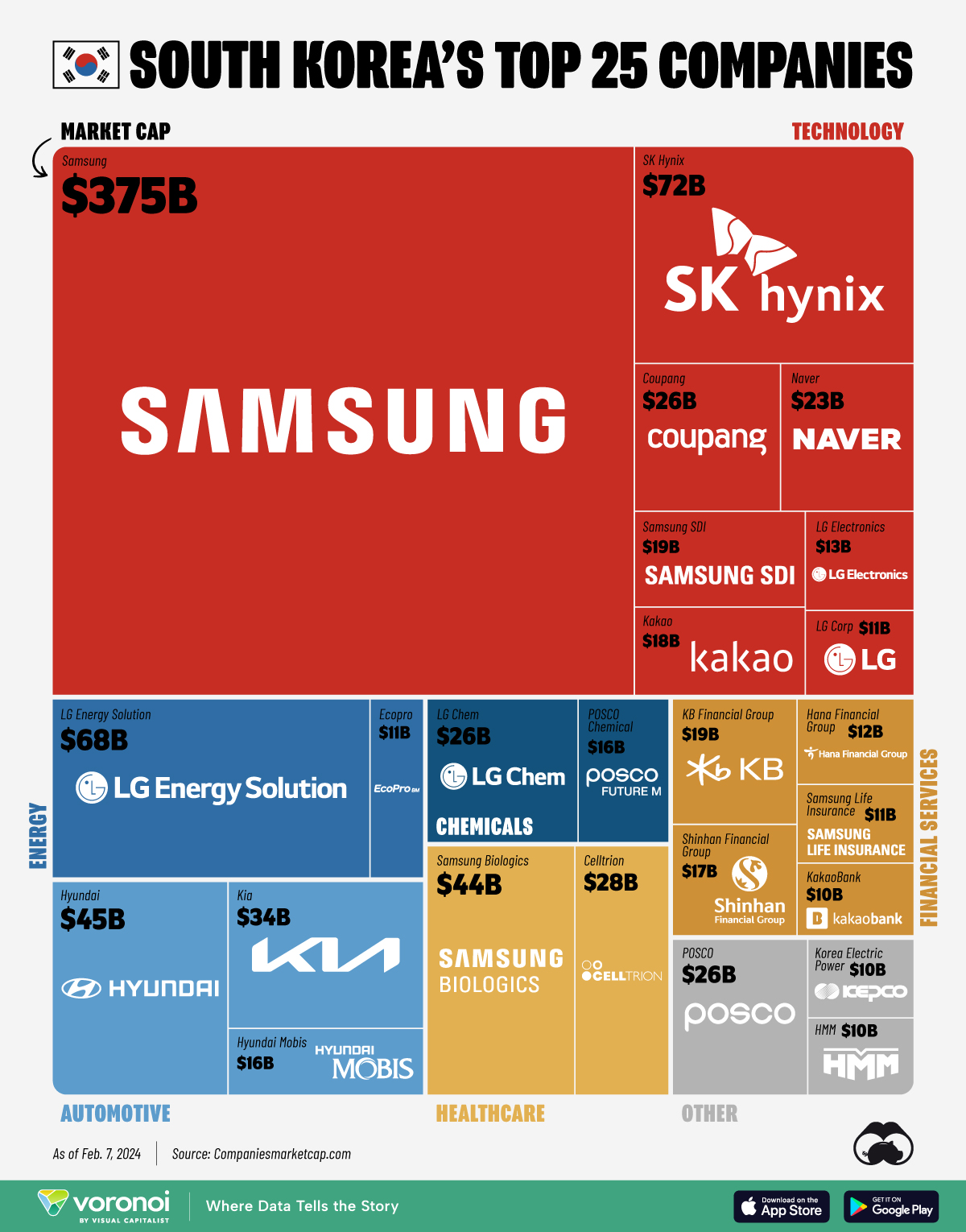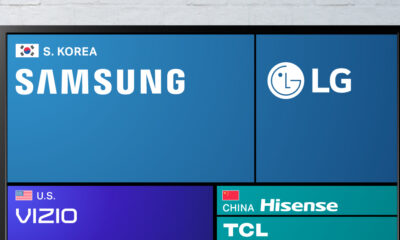Markets
Ranked: South Korea’s Largest Companies by Market Capitalization
![]() See this visualization first on the Voronoi app.
See this visualization first on the Voronoi app.
South Korea’s Largest Companies by Market Cap
This was originally posted on our Voronoi app. Download the app for free on iOS or Android and discover incredible data-driven charts from a variety of trusted sources.
In the two decades after the Korean war, rapid industrialization, dubbed the “Miracle on the Han River” transformed South Korea into an economic powerhouse.
Several major South Korean companies—now household names—were founded during this period, and are now some of the most valuable companies in the country and around the globe.
We visualize the top 25 South Korean companies by market capitalization, based on February 7, 2024 prices in USD, sourced from CompaniesMarketCap.com.
South Korea’s Top 25 Companies
South Korea’s most valuable company by a country mile is Samsung with a market cap past $375 billion, bigger than the economy of Qatar. Samsung is most popularly known for their mobile phones, but is also a major appliance maker: washing machines, air conditioners, and televisions.
Its lucrative semiconductor business supplies chips to some notable clients: Nvidia, Qualcomm, and IBM.
With its 2023 revenue close to $197 billion, Samsung is the second-largest electronics company (after Apple) in the world.
| Rank | Name | Industry | Market Capitalization |
|---|---|---|---|
| 1 | Samsung | Technology | $375B |
| 2 | SK Hynix | Technology | $72B |
| 3 | LG Energy Solution | Energy | $68B |
| 4 | Hyundai | Automotive | $45B |
| 5 | Samsung Biologics | Healthcare | $44B |
| 6 | Kia | Automotive | $34B |
| 7 | Celltrion | Healthcare | $28B |
| 8 | LG Chem | Chemicals | $26B |
| 9 | POSCO | Other | $26B |
| 10 | Coupang | Technology | $26B |
| 11 | Naver | Technology | $23B |
| 12 | Samsung SDI | Technology | $19B |
| 13 | KB Financial Group | Financial Services | $19B |
| 14 | Kakao | Technology | $18B |
| 15 | Shinhan Financial Group | Financial Services | $17B |
| 16 | POSCO Chemical | Chemicals | $16B |
| 17 | Hyundai Mobis | Automotive | $16B |
| 18 | LG Electronics | Technology | $13B |
| 19 | Hana Financial Group | Financial Services | $12B |
| 20 | Ecopro | Energy | $11B |
| 21 | Samsung Life Insurance | Financial Services | $11B |
| 22 | LG Corp | Technology | $11B |
| 23 | KakaoBank | Financial Services | $10B |
| 24 | Korea Electric Power | Other | $10B |
| 25 | HMM | Other | $10B |
In fact there are several other Samsung names in this graphic. This includes Samsung Biologics (the biotech division of Samsung), Samsung SDI (electronics and battery manufacturing), and Samsung Life Insurance (South Korea’s largest insurance company).
Meanwhile, the LG Group (formerly known as Lucky-Goldstar) is another massive Korean conglomerate (also known as a “chaebol”). This includes businesses in chemicals (LG Chem) and batteries (LG Energy Solution).
Korean carmakers Hyundai and Kia, also feature in the top 25 most valuable Korean companies.
A Brief Note on South Korea’s Chaebol System
Chaebols (family-owned conglomerates) have played a crucial role in South Korea’s rapid economic rise from the 1960s onwards.
They benefited from government support in the postwar reconstruction period, and with access to credit, allowing them to invest heavily in key industries like shipbuilding, electronics, and automobiles. This contributed significantly to the country’s export-oriented growth model.
At the same time, the sheer size and influence of chaebols can fan monopolistic tendencies in the economy, stifling competition in certain sectors, hindering the growth of smaller businesses and potentially leading to inefficiencies.
Critics argue that the chaebol system can exacerbate income inequality in South Korea, with wealth concentrated among founding families and top executives.
The concept of large family-owned conglomerates is not entirely specific to South Korea. During Japanese colonial rule (1910-1945) in South Korea, similar powerful family-controlled businesses called zaibatsu existed in Japan. The structure and influence of these zaibatsu may have indirectly influenced the development of chaebols in South Korea.
Markets
The European Stock Market: Attractive Valuations Offer Opportunities
On average, the European stock market has valuations that are nearly 50% lower than U.S. valuations. But how can you access the market?

European Stock Market: Attractive Valuations Offer Opportunities
Europe is known for some established brands, from L’Oréal to Louis Vuitton. However, the European stock market offers additional opportunities that may be lesser known.
The above infographic, sponsored by STOXX, outlines why investors may want to consider European stocks.
Attractive Valuations
Compared to most North American and Asian markets, European stocks offer lower or comparable valuations.
| Index | Price-to-Earnings Ratio | Price-to-Book Ratio |
|---|---|---|
| EURO STOXX 50 | 14.9 | 2.2 |
| STOXX Europe 600 | 14.4 | 2 |
| U.S. | 25.9 | 4.7 |
| Canada | 16.1 | 1.8 |
| Japan | 15.4 | 1.6 |
| Asia Pacific ex. China | 17.1 | 1.8 |
Data as of February 29, 2024. See graphic for full index names. Ratios based on trailing 12 month financials. The price to earnings ratio excludes companies with negative earnings.
On average, European valuations are nearly 50% lower than U.S. valuations, potentially offering an affordable entry point for investors.
Research also shows that lower price ratios have historically led to higher long-term returns.
Market Movements Not Closely Connected
Over the last decade, the European stock market had low-to-moderate correlation with North American and Asian equities.
The below chart shows correlations from February 2014 to February 2024. A value closer to zero indicates low correlation, while a value of one would indicate that two regions are moving in perfect unison.
| EURO STOXX 50 | STOXX EUROPE 600 | U.S. | Canada | Japan | Asia Pacific ex. China |
|
|---|---|---|---|---|---|---|
| EURO STOXX 50 | 1.00 | 0.97 | 0.55 | 0.67 | 0.24 | 0.43 |
| STOXX EUROPE 600 | 1.00 | 0.56 | 0.71 | 0.28 | 0.48 | |
| U.S. | 1.00 | 0.73 | 0.12 | 0.25 | ||
| Canada | 1.00 | 0.22 | 0.40 | |||
| Japan | 1.00 | 0.88 | ||||
| Asia Pacific ex. China | 1.00 |
Data is based on daily USD returns.
European equities had relatively independent market movements from North American and Asian markets. One contributing factor could be the differing sector weights in each market. For instance, technology makes up a quarter of the U.S. market, but health care and industrials dominate the broader European market.
Ultimately, European equities can enhance portfolio diversification and have the potential to mitigate risk for investors.
Tracking the Market
For investors interested in European equities, STOXX offers a variety of flagship indices:
| Index | Description | Market Cap |
|---|---|---|
| STOXX Europe 600 | Pan-regional, broad market | €10.5T |
| STOXX Developed Europe | Pan-regional, broad-market | €9.9T |
| STOXX Europe 600 ESG-X | Pan-regional, broad market, sustainability focus | €9.7T |
| STOXX Europe 50 | Pan-regional, blue-chip | €5.1T |
| EURO STOXX 50 | Eurozone, blue-chip | €3.5T |
Data is as of February 29, 2024. Market cap is free float, which represents the shares that are readily available for public trading on stock exchanges.
The EURO STOXX 50 tracks the Eurozone’s biggest and most traded companies. It also underlies one of the world’s largest ranges of ETFs and mutual funds. As of November 2023, there were €27.3 billion in ETFs and €23.5B in mutual fund assets under management tracking the index.
“For the past 25 years, the EURO STOXX 50 has served as an accurate, reliable and tradable representation of the Eurozone equity market.”
— Axel Lomholt, General Manager at STOXX
Partnering with STOXX to Track the European Stock Market
Are you interested in European equities? STOXX can be a valuable partner:
- Comprehensive, liquid and investable ecosystem
- European heritage, global reach
- Highly sophisticated customization capabilities
- Open architecture approach to using data
- Close partnerships with clients
- Part of ISS STOXX and Deutsche Börse Group
With a full suite of indices, STOXX can help you benchmark against the European stock market.

Learn how STOXX’s European indices offer liquid and effective market access.

-

 Economy2 days ago
Economy2 days agoEconomic Growth Forecasts for G7 and BRICS Countries in 2024
The IMF has released its economic growth forecasts for 2024. How do the G7 and BRICS countries compare?
-

 Markets1 week ago
Markets1 week agoU.S. Debt Interest Payments Reach $1 Trillion
U.S. debt interest payments have surged past the $1 trillion dollar mark, amid high interest rates and an ever-expanding debt burden.
-

 United States2 weeks ago
United States2 weeks agoRanked: The Largest U.S. Corporations by Number of Employees
We visualized the top U.S. companies by employees, revealing the massive scale of retailers like Walmart, Target, and Home Depot.
-

 Markets2 weeks ago
Markets2 weeks agoThe Top 10 States by Real GDP Growth in 2023
This graphic shows the states with the highest real GDP growth rate in 2023, largely propelled by the oil and gas boom.
-

 Markets2 weeks ago
Markets2 weeks agoRanked: The World’s Top Flight Routes, by Revenue
In this graphic, we show the highest earning flight routes globally as air travel continued to rebound in 2023.
-

 Markets2 weeks ago
Markets2 weeks agoRanked: The Most Valuable Housing Markets in America
The U.S. residential real estate market is worth a staggering $47.5 trillion. Here are the most valuable housing markets in the country.
-

 Education1 week ago
Education1 week agoHow Hard Is It to Get Into an Ivy League School?
-

 Technology2 weeks ago
Technology2 weeks agoRanked: Semiconductor Companies by Industry Revenue Share
-

 Markets2 weeks ago
Markets2 weeks agoRanked: The World’s Top Flight Routes, by Revenue
-

 Demographics2 weeks ago
Demographics2 weeks agoPopulation Projections: The World’s 6 Largest Countries in 2075
-

 Markets2 weeks ago
Markets2 weeks agoThe Top 10 States by Real GDP Growth in 2023
-

 Demographics2 weeks ago
Demographics2 weeks agoThe Smallest Gender Wage Gaps in OECD Countries
-

 Economy2 weeks ago
Economy2 weeks agoWhere U.S. Inflation Hit the Hardest in March 2024
-

 Green2 weeks ago
Green2 weeks agoTop Countries By Forest Growth Since 2001













